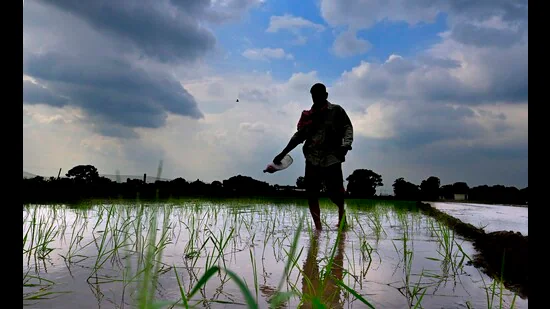Tags
Sowing almost over, Punjab eyes bumper paddy yield
By Gurpreet Singh Nibber
With water table depleting at alarming rate and pollution from stubble burning on the rise, experts say the future of Punjab’s agricultural model is bleak.

Punjab is on track for a record paddy harvest this kharif season, with 30.94 lakh hectares already sown. While farmers are jubilant over the predicted bumper crop, experts are sounding the alarm over the long-term ecological damage the practice may be causing.
Punjab is expecting a paddy yield of 185 lakh tonnes this year, a marginal increase from the last season’s figure of 182 lakh tonnes.
With the state’s water table depleting at an alarming rate and pollution from stubble burning on the rise, experts say the future of Punjab’s agricultural model is in question.
According to figures released by the agriculture directorate, the coarse paddy grain covered under the minimum support price (MSP) has been sown over 25.19 lakh hectares and 5.75 lakh hectares are under the premium aromatic variety basmati.
“It is going to be a good crop because at time of sowing, the conditions were ideal with abundant rainfall and most conducive temperature,” said Punjab agriculture director Jaswant Singh, adding that 50,000 to 60,000 hectares more area is expected to be under the crop.
Experts in the agricultural field are worried that this non-native crop may bring “momentary respite” to farmers but “spell doom for Punjab’s ecology”. Paddy was never grown over 30-lakh hectares in the state, and it has eaten into the area of other kharif crops such as maize and cotton. The state’s diversification plan has taken a severe beating, say experts.
Despite favourable weather conditions and abundant rainfall during the current paddy sowing season, experts warn that Punjab’s heavy reliance on paddy farming is exacerbating its water crisis. With 14.5 lakh tubewells used for irrigation and 70% of the state’s revenue blocks in the “dark zone”, water resources are dwindling rapidly. On an average, the water table drops by one metre annually in the state, a trend that threatens the sustainability of all crops, including paddy, according to agri experts.
Former vice-chancellor of Punjab Agricultural University (PAU) Sardara Singh Johal, who also worked with the Indian Council for Agricultural Research (ICAR), said paddy yield is not an issue in Punjab, but we must be concerned about the depleting water table. “Without water, no crop will survive. So to conserve water, we must stop cultivating paddy,” he suggested.
While the record paddy harvest is hailed as a success for farmers, experts argue that the state’s agricultural model needs urgent reform. BS Dhillon, former vice-chancellor of PAU, pointed out that the dependence on paddy is unsustainable due to water scarcity and environmental degradation. He stressed that diversifying crops is crucial to preserving Punjab’s agricultural future.
“We must shift to more water-efficient crops like maize, millets, and cotton to reduce the burden on water resources,” said Dhillon.
Surplus stocks a strain on storage
Punjab’s bumper paddy harvest could bring 185 lakh tonnes of new rice, adding to the already existing stock of 80 lakh tonnes from last season. This will lead to overstocking and potential wastage, straining storage facilities and financial resources.
“While the farmers benefit in the short term, the state could face logistical challenges with excess stocks,” said Jaswant Singh, director of agriculture, Punjab.
One of the most pressing environmental concerns is the burning of paddy stubble. Annually, Punjab produces about 190 lakh tonnes of paddy straw, most of which is set ablaze, contributing to severe air pollution across northern India. The thick smog caused by stubble burning worsens air quality in cities like Delhi, especially during the winter months, posing a serious health hazard.
The state has sought ₹500 crore for managing paddy stubble which could be used for diversification in case the practice of paddy cultivation is stopped. Since 2018, a total of ₹1,700 crore has been spent as subsidy on farm machinery for in-situ and ex-situ management of paddy stubble.
https://www.hindustantimes.com/cities/chandigarh-news/sowing-almost-over-punjab-eyes-bumper-paddy-yield-101753033517716.htmlPublished Date: July 22, 2025






